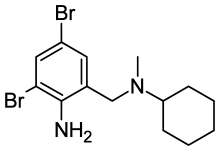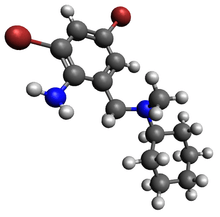Bromhexine
Bromhexine is a mucolytic drug used in the treatment of respiratory disorders associated with viscid or excessive mucus.[1]
 | |
 | |
| Clinical data | |
|---|---|
| AHFS/Drugs.com | International Drug Names |
| Pregnancy category |
|
| ATC code | |
| Legal status | |
| Legal status |
|
| Pharmacokinetic data | |
| Bioavailability | 75-80% |
| Elimination half-life | 12 hr |
| Identifiers | |
| |
| CAS Number | |
| PubChem CID | |
| DrugBank | |
| ChemSpider | |
| UNII | |
| KEGG | |
| ChEBI | |
| ChEMBL | |
| CompTox Dashboard (EPA) | |
| ECHA InfoCard | 100.020.622 |
| Chemical and physical data | |
| Formula | C14H20Br2N2 |
| Molar mass | 376.136 g·mol−1 |
| 3D model (JSmol) | |
| |
| |
| | |
It was patented in 1961 and came into medical use in 1966.[2]
Function
Bromhexine is intended to support the body's mechanisms for clearing mucus from the respiratory tract. It is secretolytic, increasing the production of serous mucus in the respiratory tract, which makes the phlegm thinner and less viscous. This contributes to a secretomotoric effect, allowing the cilia to more easily transport the phlegm out of the lungs. For this reason it is often added to cough syrups.
It has been shown to increase the proportion of serous bronchial secretion, making it more easily expectorated. It is indicated as "secretolytic therapy in bronchopulmonary diseases associated with abnormal mucus secretion and impaired mucus transport".
Bromhexine is contained in various formulations, high and low strength syrups 8 mg/5 ml, 4 mg/5 ml, tablets and soluble tablets (both with 8 mg bromhexine) and solution for oral use 10 mg/5 ml, adapted to the need of the patients. The posology varies with the age and weight, but there are products for all age groups from infant on. Bromhexine is well established and tolerated.
Brand names
- Broncholyte Elixir
- Bisolvon
- Paxirasol
- Barkacin
- Bromhexin
- Vasican
- Bisolex
- Robitussin Chesty/Forte
- Duro-Tuss Chesty/Forte
- Benadryl Chesty/Forte
- Movex
- Bromex
- Solvex
- Mucolyte
- Brofentol
- Brofentol Plus
- Dysolvon
- Flegamina
- Ventilate Forte (combination of bromhexine and salbutamol)
- Cofdex
References
- Morton, Ian; Hall, Judith (1999). Concise Dictionary of Pharmacological Agents. Springer. p. 55. ISBN 0-7514-0499-3. Retrieved 2009-06-03.
- Fischer, Jnos; Ganellin, C. Robin (2006). Analogue-based Drug Discovery. John Wiley & Sons. p. 544. ISBN 9783527607495.